#asian species
Text
Tajikistan landrace LGD - mostly from Latif La




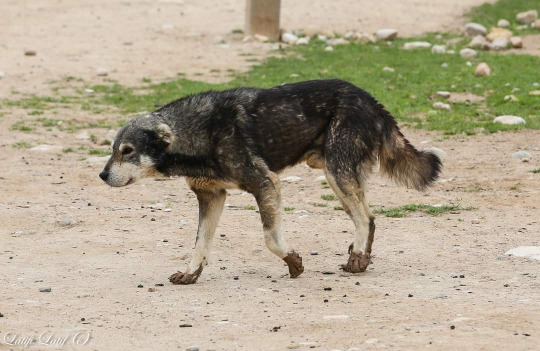


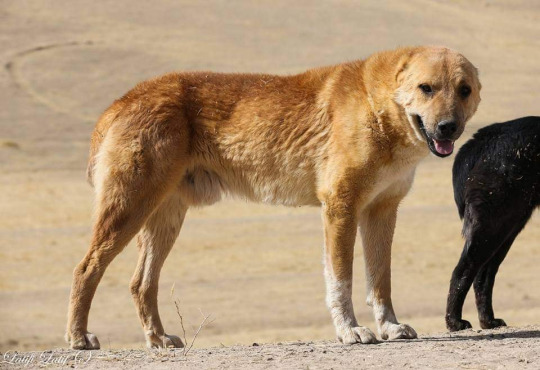



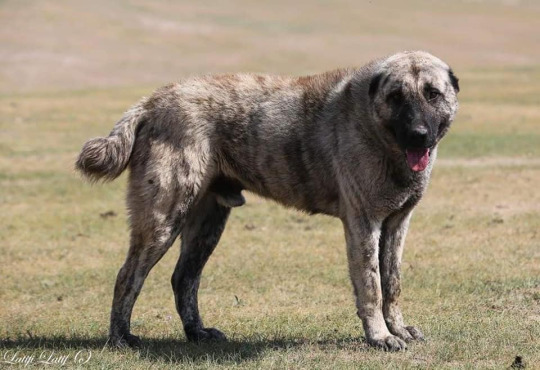





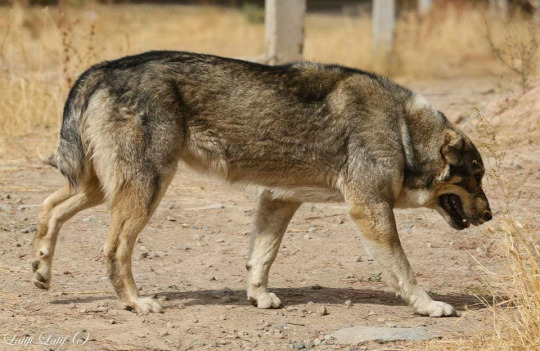

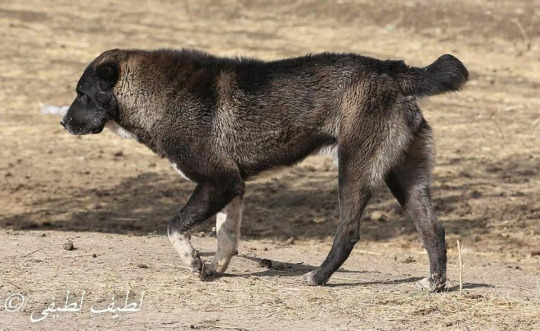
#LGD#livestock guardian dog#central asian shepherd#cas#landrace#landrace dog#tajikistan#tajikistan dog#these are just the ones i wanna use as inspiration for my project btw#not necessarily a representative sample#they seem to come in every color except merle#not that i was looking super closely#preeeeeeeetty sure latif la was credited for all of these but not 100% sure#they're from a random working dog fb group lol#thylakanis#thylakanis universe#i wanna use these for the bulky solo-pair hunting thylakanis species#combined with thylacine and some of the prehistoric caniforms
3K notes
·
View notes
Text
Some good news from Indonesia: the Sumatran Rhino Sanctuary in Way Kambas National Park has just announced that on November 25th their female Sumatran Rhino named Delilah gave birth to a healthy male calf!!!

(Photo credit: Indonesian Ministry of Environment and Forestry)
The as of yet unnamed calf is the second calf born at the sanctuary this month, and his mother Delilah was the second calf ever born at the sanctuary as well as the first captive bred Sumatran rhino to successfully give birth in captivity, so this is great news for captive breeding efforts of this species. There are only somewhere between 34 and 47 Sumatran rhinos in the wild, so captive breeding is incredibly important for this species survival. The sanctuary plans to eventually release the rhinos born at the sanctuary in order to help build the wild population back up. This baby is the fifth calf to be born at the sanctuary, and in addition to being Delilah’s first calf, he is also the first calf to be sired from his father, Harapan, who was originally born in the Cincinnati Zoo.

The mother and calf are currently being held in a naturalistic enclosure at the sanctuary (as the goal is to try to get them to live a life as similar to in the wild as possible) and are being heavily guarded to protect them from poachers. This species has suffered so much due to a combination of poaching for their horns as well as habitat loss. They are also pretty hard to keep and breed in captivity due to their shy nature, so this calf is amazing news!
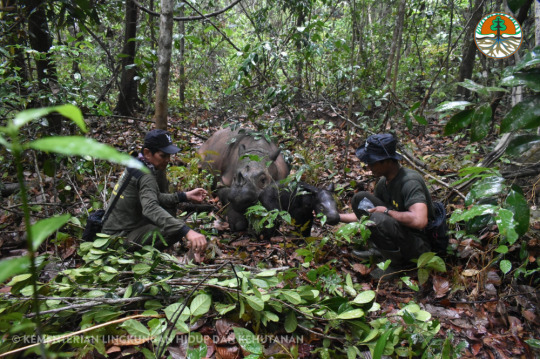
Also! Fun fact: this species of rhino is the closest living relative of the extinct Woolly Rhinoceros (Coelodonta antiquitatis). Which makes sense since the Sumatran rhino is the hairiest of all the living rhino species, which you can especially see with the babies.
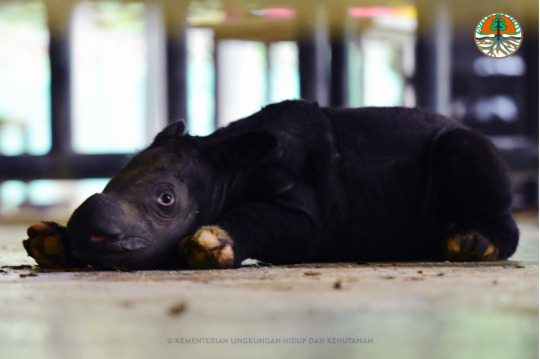
#indonesia#Indonesian wildlife#rhinoceros#sumatra#Sumatran rhinoceros#conservation#endangered species#good news#baby animals#baby rhino#wildlife#asian wildlife#animals#animal lover
329 notes
·
View notes
Photo
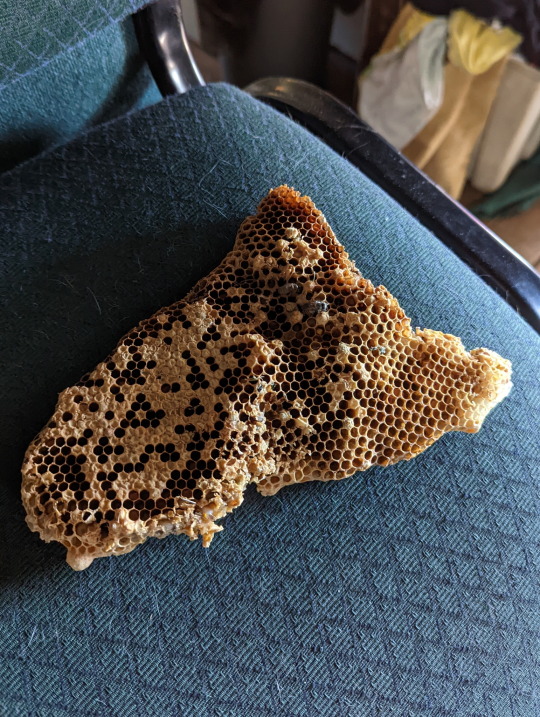
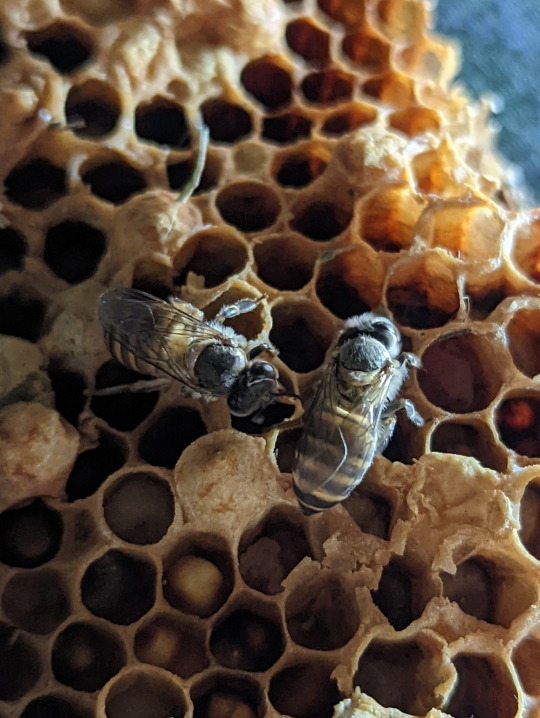
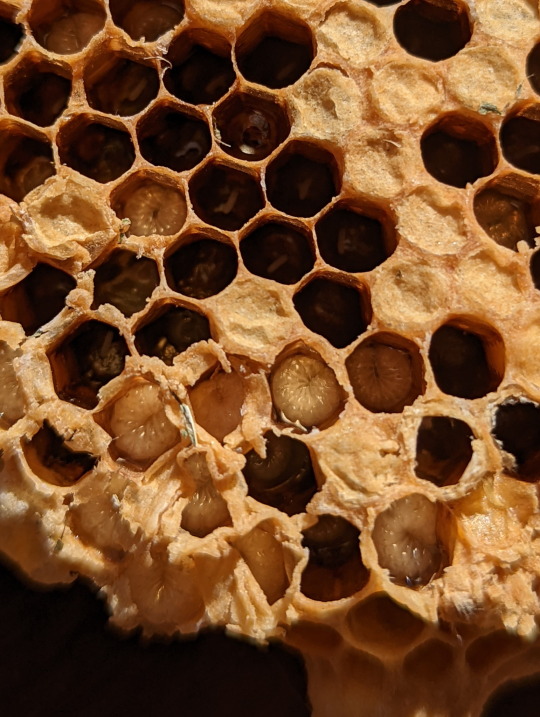
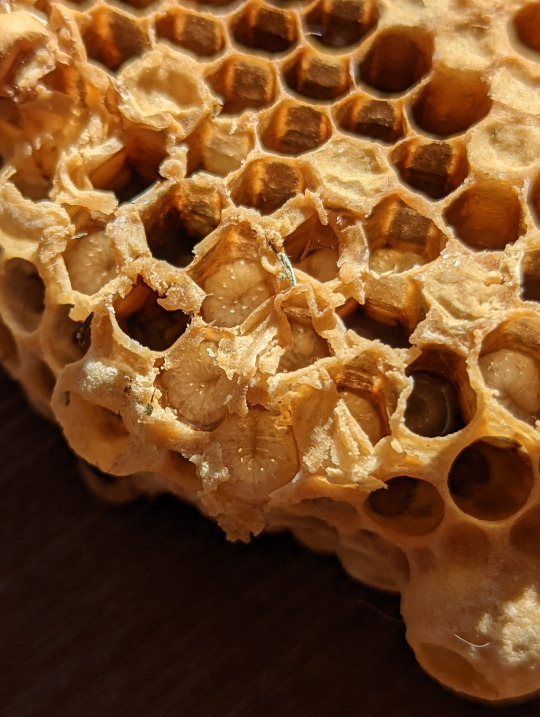
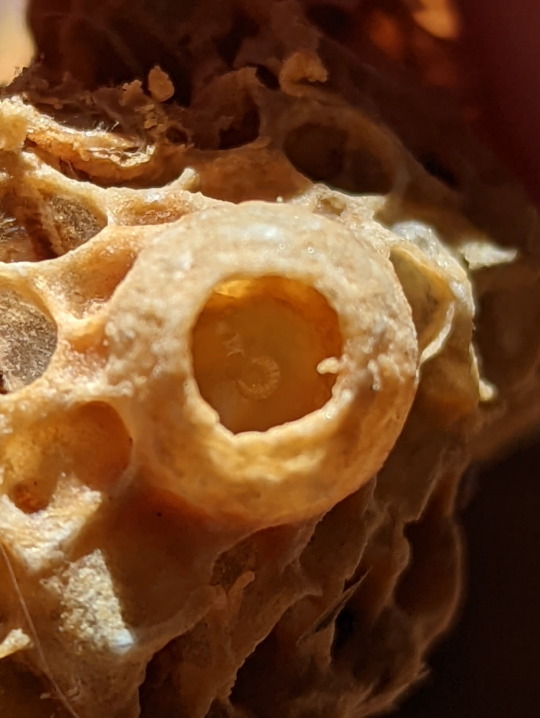


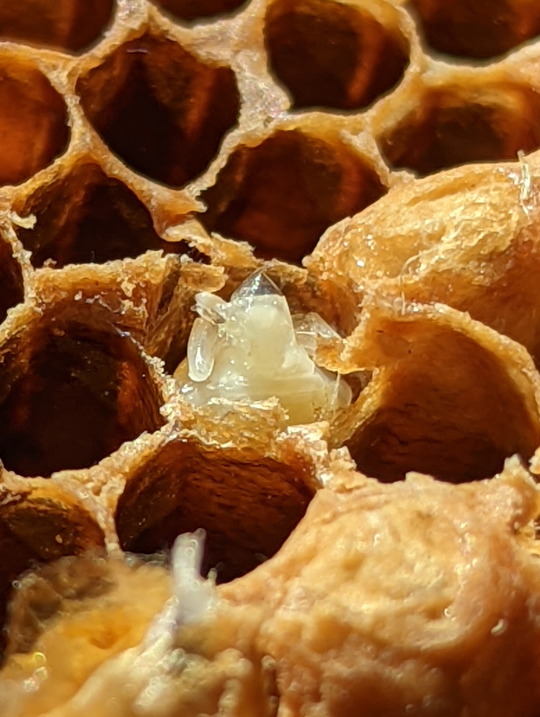
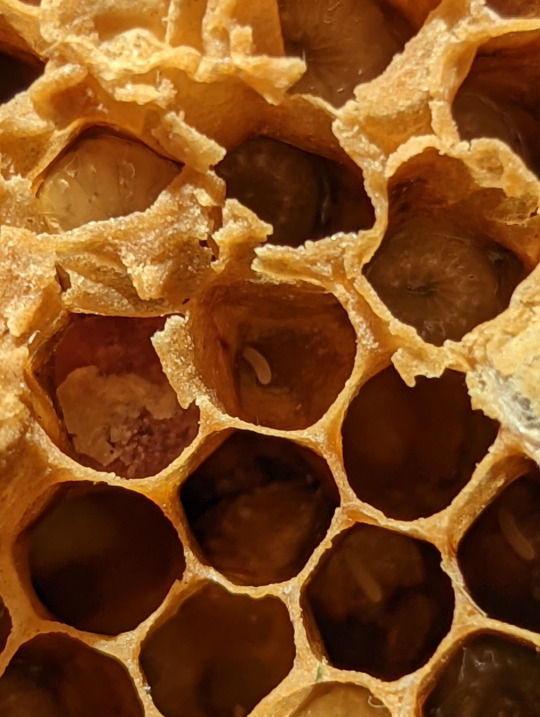
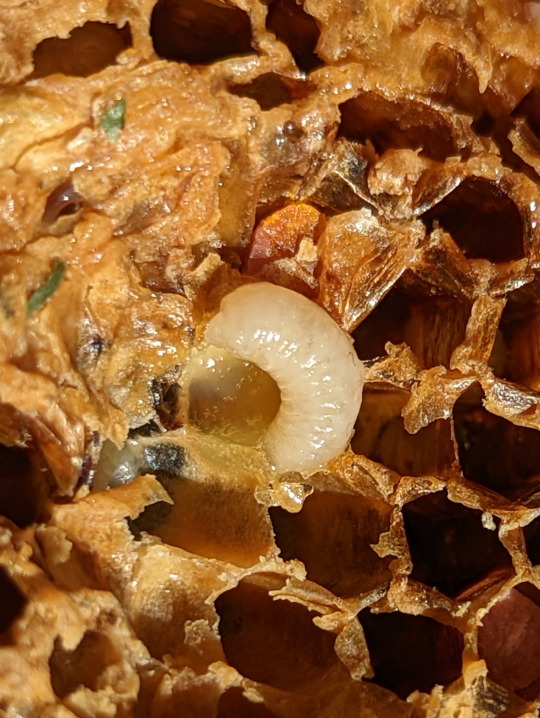
Nest of the Asian Honeybee
Here we have the poisoned nest of the Asian Honeybee (Apis cerana). If you’re wondering why the nest was poisoned, it’s because this species is actually quite damaging to this area. The Asian Honeybee not only leaves in competition with native bees over nesting areas and food, but they may also carry a certain nasty mite known as the ‘Varroa mite’ (genus Varroa), which can be detrimental to European Honeybee populations (Apis mellifera) (1).
Lets take a closer look at this nest shall we. First we’ll start off with the eggs. You can see an egg inside a brood cell in picture 9. The eggs are very small, and take about three days to develop. After which the fat little larvae emerge, curling up and waiting to be fed by the worker bees. When the larva becomes large enough, the brood cell will be sealed, so the larva’s pupation will be undisturbed. The adult bee will chew its way out of the cell after emerging from the pupae (2).
You can tell which brood cell belongs to which kind of bee based on its appearance. The drones have a distinctly dome-shaped cap with a large pour in the center (pic. 7). Then, of course, there’s the queen’s brood cell, which is large, round and on the edge of the nest (pics 5-6) (3).
When it comes to this species, it’s important to stay informed about the ways in which they are damaging for the environment.
Source (1)
Source (2)
Source (3)
Apis cerana
14/07/22
#Apis cerana#Asian Honey Bee#Apis#Cavity-nesting Honey Bees#Honey Bees#Apini#Anthophila#Bees#Hymenoptera#Varroa#Varroa Mites#Acari#Mites#invasive species#bugs#bugblr#bugs tw#bug#insects#insecta#insectblr#insects tw#entomology#insect#Arthropods#Arthropoda#beehive#hives#nests#invertblr
598 notes
·
View notes
Text

Pallas’ cat, also known as the manul.
Native to Central Asia. Endangered.
385 notes
·
View notes
Text
For #FishFriday:

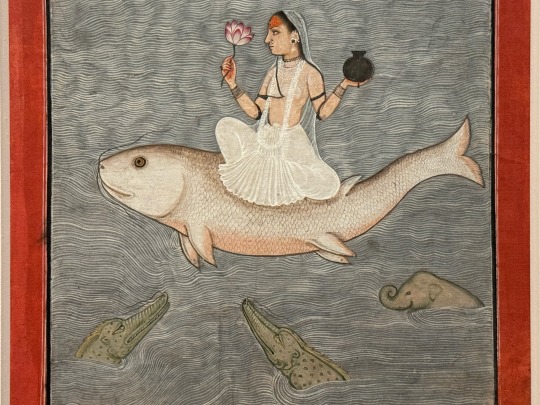

The Goddess Ganga
c. 1650-75
India (Mandi, Himachal Pradesh)
opaque watercolor, gold, & silver on paper
on display at Philadelphia Museum of Art
“The Hindu goddess Ganga personifies India's most important river, the holy Ganges, that begins high in the Himalayan mountains and flows south into the Bay of Bengal. Here she holds a vessel brimming with Ganges water while sitting atop an enormous fish — the humpback mahseer, a species of carp native to the Ganges.
Ganga also holds a lotus flower, a symbol of purity and abundance. Mythical creatures peek from the waves and waterbirds soar across dark monsoon clouds.”
#animals in art#museum visit#bird#birds#birds in art#painting#watercolor#miniature painting#Philadelphia Museum of Art#Indian art#South Asian art#17th century art#Hindu art#fish#Ganga#Ganges#humpback mahseer#species ID
35 notes
·
View notes
Text
Wet Beast Wednesday: invasive carp
I've mentioned on a few posts that in a previous job I helped remove invasive carp from the Mississippi river and drainage. For this Wet Beast Wednesday I'll discuss the three species that I personally helped remove: the silver carp, bighead carp, and grass carp. The common carp (Cyprinus carpio) and block carp (Mylopharyngodon piceus) are also invasive in North America, but I didn't remove either of those: the black carp because they haven't made it as far north as the area I worked and the common carp because the state governments where we worked considered them commercially important species. All the invasive species collectively described in America as invasive carp or Asian carp are large fish from the family Cyprinidae who are native to east Asia. They have been introduced to areas far beyond their native range for use in aquaculture and for food. Carp aquaculture in China goes back over a thousand years and the three species plus the black carp are known as the "four domesticated fish" for their importance in food and traditional medicine. The carp were introduced to America to clean aquacultural and decorative ponds and quickly escaped into the river system. They are now highly invasive throughout the Mississippi river basin and have also spread into other river systems, including the Illinois and Ohio rivers. All the introduced carp species are considered highly invasive due to outcompeting native species, lacing predators as adults, and their hardiness allowing them to thrive in harsh conditions.

This picture isn't informative at all, I just thought it was funny (image: a close-up of the head of a silver carp, showing its eye and large, open mouth)
Silver carp (Hypophthalmichthys molitrix) made up the majority of the carp I caught. In their native range (from Vietnam to eastern Siberia), silver carp are actually considered threatened due to overfishing and habitat loss. Outside of their native range, they have become highly invasive in multiple parts of the world. Silver carp notable for their large head and silvery scales, which become brighter in healthier fish. They reach an average of 60-100 cm (24-39 in) and 9 kg (20 lbs), but can reach a maximum size of 140 cm (55 in/4.6 ft) and 50 kg (110 lbs). They are filter-feeders, primarily dining on phytoplankton but also eating zooplankton and organic particles. To catch food, they use specialized gill rakers that have fused together into a spongy surface and is coated with mucus that traps particles. As with all Cyprinids, silver carp lack stomachs, instead having their intestines attaching directly to the esophagus. Lacking a stomach makes the fish less efficient in their digestion and they feed near constantly. Silver carp were introduced to America to clean blue-green algae from ponds, aquaculture facilities, and water treatment plants. They consume so much plankton that they can outcompete local species, such as freshwater mussels, paddlefish, buffalo, and shad, as well as larval fish of most species.

(image: a silver carp being held by a person (offscreen). The fish is seen from the side. It is a large fish with a silver color. Its head is relatively large and has no scales. The eye is unusually low on the head)
Silver carp migrate upriver to broadcast spawn, with their eggs and larvae being washed downstream where they grow in shallow waters like floodplains. Silver carp trapped in places without flowing water will not spawn, instead reabsorbing their gametes. Males have rough skin on the front of their pectoral fins, which they will scrape against the bellies of female to induce them to release their eggs. Females that have spawned at least once often have scars on their bellies that can be used to identify that they have reproduced. Silver carp reach sexual maturity between ages 4 to 6 and can live up to 20 years.

I believe I can fly! (image: a silver carp in profile midway through a jump out of the water)
Silver carp are famous for leaping out of the water when startled. They can reach up to 3 m (10 ft) out of the water, though larger individuals are less likely to jump. The sound of boat engines can easily spook the carp into jumping and there are many videos out there of boats moving through rivers surrounded with dozens to hundreds of jumping carp. The jumping behavior combined with the sheer size of the fish makes them a hazard to boaters, as colliding with a carp can damage boats and cause serious injury. Interestingly, carp in their native range are much less likely to jump than those in North America. The reason for this in unknown though it could be because carp in America live in much higher population densities than those at home. It is also possible that the carp first introduced to America happened to have a trait making them more likely to jump and this trait has been passed down to most modern carp.

(image: a small boat with three people on it. In the foreground, dozens of silver carp are jumping out of the water, causing the water to become frothy)

(gif description: a man is sitting on a running boat. A silver carp jumps in from the right side of the frame and hits him in the face, knocking his baseball cap off)
The bighead carp (Hypophthalmichthys nobilis) is closely related to the silver carp, enough so that they can hybridize to make fertile offspring. Bighead carp have darker scales and larger heads, but what really makes them stand out is their size. They reach an average of 60-100 cm (2-3 ft) and 18 kg (40 lbs) but can reach a maximum of 160 cm (5.2 ft) and 50 kg (110 lbs). They fill a similar ecological nice to silver carp, both species being filter feeders with specialized gill rakers used to filter out plankton. Bighead carp prefer zooplankton in contrast to silver carp targeting phytoplankton. They are highly valuable in aquaculture as they grow quickly, allowing for a lot of meat to be developed relatively quickly. Like silver carp, they swim up river to spawn and reach sexual maturity between 2 and 3 years. They can live up to 16 years. Bighead carp will also jump, but are less likely to do so, especially once they mature, and are therefore less notorious than silver carp.

(image: two bighead carp underwater, one closer and to the bottom right and one farther away at the top left. They are very similar in appearance to the silver carp, but have larger heads and darker scales, making them look brown. The closer fish has its mouth open)
Grass carp (Ctenopharyngodon idella) were the species I caught the least. They can be distinguished from the other two with their long, skinny, and round bodies, larger sales, and green coloration. Unlike the other two, grass carp are herbivores with teeth that feed on aquatic vegetation, though they also consume detritus and invertebrates in smaller amounts. Grass carp can eat up to a few times their weight in food a day. Grass carp can destroy whole patches of aquatic vegetation, which removes food sources for other animal, removes refuges for fish and other animals to hide, and can drastically alter the trophic web of local areas. They live in still ponds or rivers with slow currents, but move into fast-flowing rivers and swim upstream to spawn. They can reach between 60 and 100 cm (23.5 - 39.5 in) on average, but can get up to 2 m (6.6 ft) and 45 kg (100 lbs). Grass carp were first introduced to America to act as weed control in ponds before escaping into the wild. It is still possible to import grass carp for weed control, which is astonishing to me since thats how we got into this mess in the first place. Grass carp are highly valuable in fisheries and are used as a food source throughout their native range. They are the most farmed fish by biomass, with over 5 million tonnes of grass carp produced in fisheries every year. The second most farmed fish is the silver carp.

(image: a grass carp underwater. Its body is slender and torpedo-shaped, with large, distinct, green scales. Its head is scaleless and its eye is level with its mouth. A second fish is peeking into frame at the bottom right)
One of the problems with controlling carp in America is the lack of a market for them. They are not commonly eaten in America despite being a major food source in China and other parts of east Asia. This is in part because of the association the phrase "Asian carp" has with the common carp, which was introduced to North America before the other species and is generally considered to have poor-quality meat. Because there is no market for invasive carp, fishermen do not bother removing them from the rivers and many do not bother taking the time to kill the ones they do catch. A few conservation efforts are attempting to make a market for the carp so that fishermen will take them. When I was at my last job, we gave the carp we caught to someone who used them for fertilizer and bait. A current effort by the Illinois Department of Natural Resources and the U.S. Environmental Protection Agency is to rebrand the carp as Copi (from copious) in an attempt to get around the stigma that carp tastes bad and get Americans to start eating them. Copi is currently being sold in or distributed to multiple states and DC. The project has already exceeded the expected amount of fish removed in weight for the first year. Other rebrand attempts include Silverfin, the perfect catche, and (my personal favorite) Kentucky tuna. This rebranding is part of a major push to try to keep the carp out of the Great Lakes, though grass carp have already gotten into Lake Erie. If you can't beat them, eat them.

Image: the copi logo. It is the word "copi" written in a dark blue, blocky, minimalistic font. The letter O is replaced by a simplistic drawing of a light blue fish, whose tail forms the curve in the letter C)
#wet beast wednesday#asian carp#carp#silver carp#bighead carp#grass carp#invasive carp#invasive species#fish#fishblr#fishposting#conservation#freshwater biology#freshwater fish#freshwater ecology#biology#zoology#ecology#animal facts
80 notes
·
View notes
Text
today im thinking about malaria in ancient rome.
about the fact that P. falciparum (the most dangerous kind of malaria) was likely endemic at least from the 2nd century BC onward
that Galen said semitertian fevers (P. falciparum infections) were more common in Rome than anywhere else in the Roman Empire
that the most severe manifestations of P. falciparum (quotidian fevers + cerebral malaria) were most common in babies and young children, an epidemiological observation that indicates the transmission rate of P. falciparum was extremely high in Rome
that Quintus Serenus said there was no Latin word for semitertian fevers (they used a transliteration of the Greek, 'hemitritaeos') because "no one, i think, could have named it in our language and mothers would not have wanted to"
#working on my thesis gonna bring down the mood of the whole department#but i feel like i have to honor them#and the thing about malaria that fucks me up is P. falciparum has been around for tens of thousands of years#its not a disease of agriculture like smallpox or of sanitary issues that come with civilization like typhoid#it predates agriculture its been found in the bodies of mummies from ancient egypt and skeletons from ancient greece and rome#there are species-specific plasmodium parasites for gorrillas chimpanzees and humans#which to me indicates there was a plasmodium parasite for every now lost hominid#malaria is the strongest recent evolutionary pressure on the human genome#upwards of 30% of people in some parts of the world are heterozygous for sickle cell anemia#or heterozygous for SE asian ovalocytosis#thus it was more evolutionarily advantageous for 2-3% of all children to die#so about 30% of people could be protected from severe malaria#these mutations take a long time to evolve. parasites take a long time to evolve#there are people who mourned their infants tens of thousands of years ago in languages we will never know with rituals we will never see#and i cant do anything about any of that but i can keep going to the lab every day and trying my best to figure it out#because so many generations of humans stretching back to before we were human could not
27 notes
·
View notes
Text
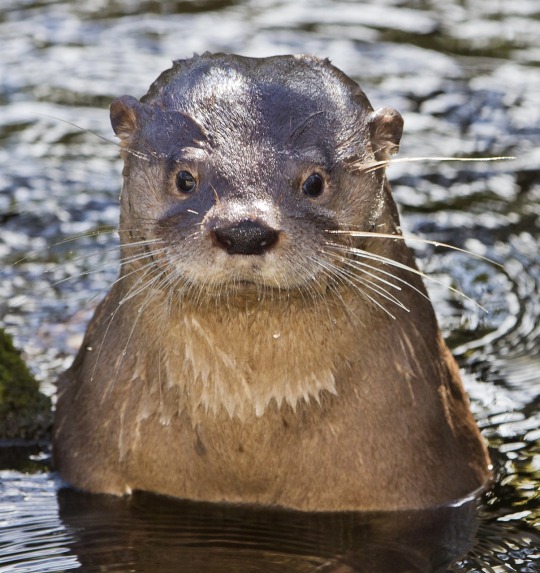
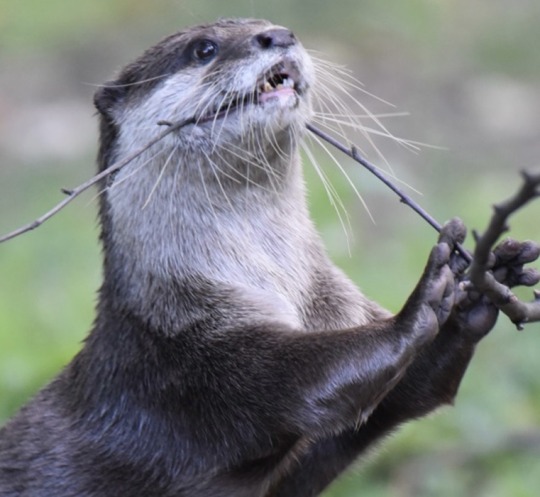
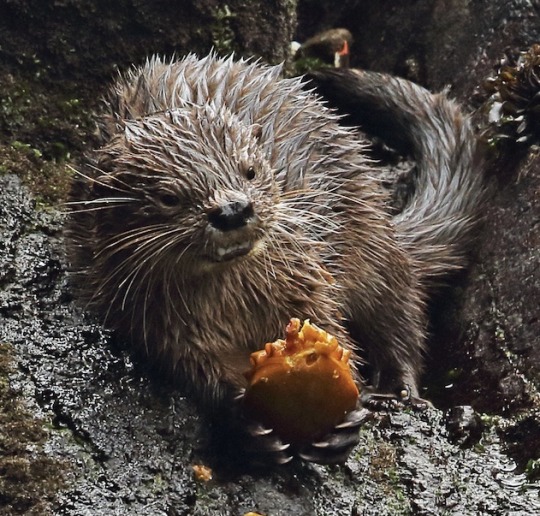

Image 1 : Southern river otter - Lontra provocax
Fun fact: Southern river otters live in freshwater with riparian vegetation. Riparian vegetation protects the water from hot summers and cold winters, shielding the waters so that the aquatic life living there won't become distressed.=(^.^)=
Image 2 : Asian small-clawed otter - Amblonyx cinereus
Fun Fact: asian small-clawed otters are the smallest of all other otter species. They also have whiskers called vibrissae that detects movement of prey in the water. ( ^w^)
Image 3 : Marine otter - Lontra Felina
Fun Fact: Marine otters are the only species with the genus Lontra that is found in marine habitats. Sometimes they even eat fruits! (╹◡╹)
September 19 , 2023(*^o^*)
@meowzerswhirlingsomewhere
#marine biology#ocean#rivers#fun facts#meow#marine science#scientific names#endangered species#aqua life#aquaculture#otters#sea otter#river otter#asian small clawed otter
70 notes
·
View notes
Text
hey how many of you know that ladybugs are endangered
#listen to my gibberish boy#just wondering because I feel like its not common knowledge but holy fuck it should be!!!!!!!#'but I see so many ladybugs!!!' its likely that most of those are asian lady beetles#an introduced species#they look almost identical#I might reblog with more info on this if anyone is interested
35 notes
·
View notes
Text

Sumatran Elephant Elephas maximus maximus
Family: Elephantidae
Genus: Elephas
Conservation Status: Critically Endangered
Working on this one was a real challenge. The lighting of the photo was difficult to figure out, and the shapes on the head were at an angle that I wasn't familiar with. Anyway, the outcome got me satisfied. I had no idea about this subspecies until I got to study elephants. Very interesting subspecies.
Join the club to know more about this and more animals. Also, you can get access to the book in the making and the Esticker album.
Click here
____________________________________________
Thank you guys for your support. If you like the content please like and subscribe. Deeping into animals that we think we know every week
#elephant#sumatran elephant#elefante#illustration#drawing#scientific illustration#illo#wild animals#artist on tumblr#wildlife#animals#mammals#cute animals drawing#conservation#critically endangered#endangered species#infographic#infografía#asian elephant#animal
31 notes
·
View notes
Text

Malayan Tapirs 5-6-23
Hell is a place where you have to draw a tapir’s head at ¾ view.
I didn’t end up drawing any baby tapirs, but it's important for you all to know they have markings like a watermelon.
#tapir#malayan tapir#asian tapir#conservation#wildlife conservation#endangered species#endangered animals#biology#zoology#sketch#art study#digital art#digital illustration#digital sketch#perissodactyl
91 notes
·
View notes
Text
Phylogenetic wild cat tournament
Bay cat lineage - Final
Genus: Catopuma & Pardofelis
Depth: 7 (6 wins away from championship)

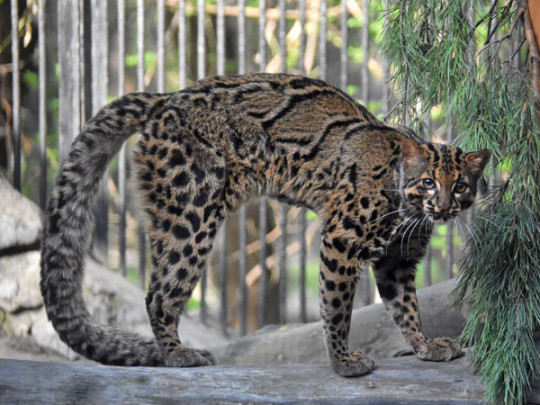
Aaaand the bay cat lineage final!
(How long is the marbled cat's tail huh.)
Asian golden cat


Marbled cat


#polls#cats#tournament poll#phylogenetic wild cat tournament#bay cat lineage#asian golden cat#marbled cat#asiatic golden cat#sorry i don't really have anything to say here these are both quite mysterious species not much is known about them#the marbled cat has webbed paws. there. a fun fact.#and with this we're halfway along the tournament!
38 notes
·
View notes
Text
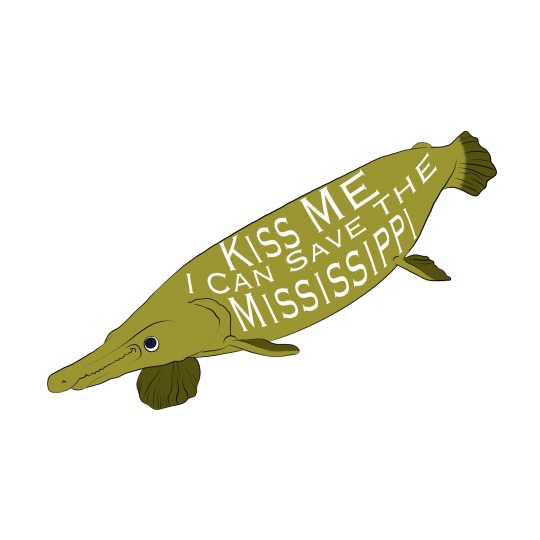
Did you know that Asian Carp are an invasive species threatening the health of the Mississippi River? But the Alligator Gar could help! They’re not a particularly beloved species as they are large and have lots and lots of sharp teeth, but supporting their population could save the Mississippi. The real fear is that if the Carp reach the Great Lakes, our ecosystem will be throw totally out of whack.
I mean, look at this dumb asshole, who wouldn’t want that in their river?
I’m just starting this project, but eventually I’d like to have all my art made into pins and stickers that will generate donations, this guy would obviously donate to the restocking of the Gar population in the Mississippi River.
#alligator gar#mississippi#asian carp#invasive species#conservation#ecosystem#great lakes#save the planet
136 notes
·
View notes
Text


Asian woolly-necked stork/ Asian woollyneck. A Near Threatened species of bird.
#asian woollynecked stork#asian woollyneck#woollyneck#stork#near threatened species#bird#birds#water birds#wetland#wetlands#near threatened bird species#indian birds#birds of maharashtra
6 notes
·
View notes
Text
Today I went out on the ocean and saw puffins. They're so neat!
Also learned that indeed I am prone to motion sickness.
10/10 wouldn't do it again
#i even took Dramamine#but not before getting on the boat#also my recurrent inability to tell the difference between hunger and nausea didn't help#I thought I was just hungry for like a full half hour before I realized that actually I was feeling unwell and it was the motion causing it#what is it with bodies#finally those ginger chews I had to buy at the Asian grocery store to bring my purchase of edible alkali up to the $5 minimum#so glad they had those at the counter as the thing to grab#because I do like to keep them handy but this was the first time I had needed to use them since that day a couple weeks ago#me!#gpoy#oh but anyway the puffins were neat#also saw other neat birds#birding#my life list is now longer by at least two species#buddy went to Ecuador earlier thia month and his is up by 300+#but it's not a competition#seals and an otter too!
14 notes
·
View notes
Text


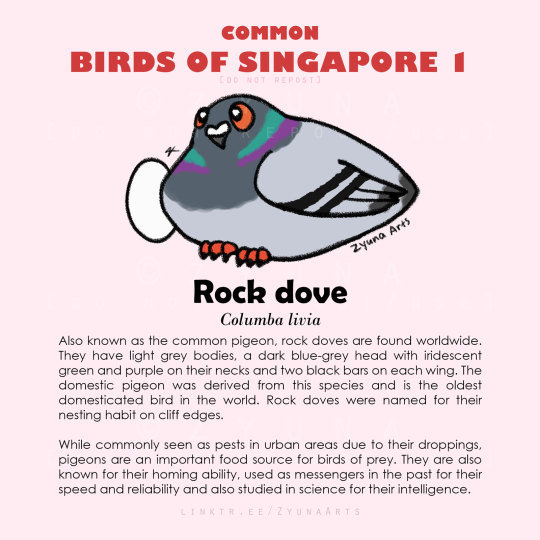
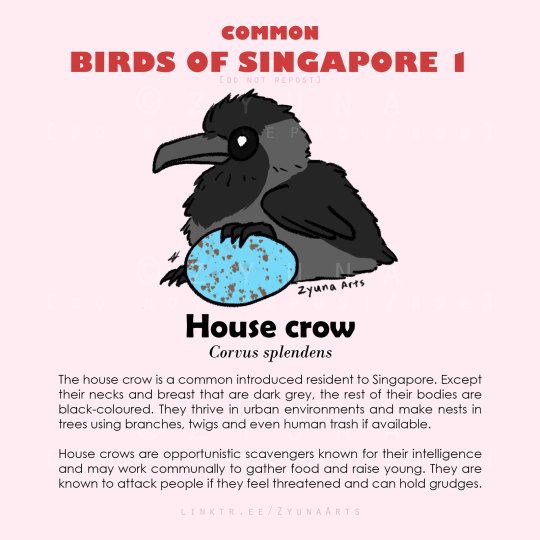
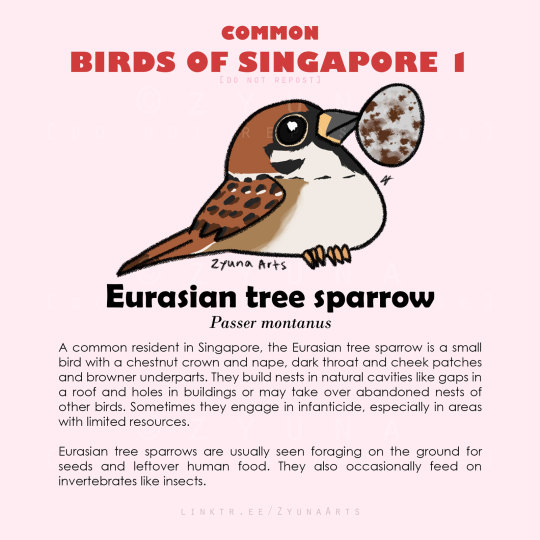







COMMON BIRDS OF SINGAPORE
I had this idea lingering in my mind for some time as I always wanted to showcase some of the wildlife found in my urban country. I decided to bring this idea to life after I realised Easter was around the corner and I could do something bird/egg-themed! Each adorable birb will be debuting as small prints (collage pieces) and individual water-resistant stickers for @martsuri.sg and later available on my online st0re 🌸
I had fun researching these birds, especially finding out what their eggs looked like 👀 I drew the fluffy chicken at first and then the crow, then realised the chicken didn't match the rest in terms of style since I drew the rest of birds in their adult colouration :") I didn't want to scrap the chicken, so left it as is. Those brown markings were based off red junglefowl chicks.
I have a soft spot for rock doves/pigeons and crows! They're often overlooked or get a bad rep but I love them a lot. They're just misunderstood.
I've seen most of these featured species in person before, especially spotted and zebra doves! There's also black-naped orioles I often see in my neighbourhood. As of posting this, I've yet to see any Asian koels in person despite hearing them all the time 👀 I read a theory somewhere since they're such sneaky (and lazy) parents, they prefer to hide where you can't see them but can hear them loud and clear, much to the dismay of many locals who call them 'annoying'. I even heard a man yelling "QUIET!!!" to a male koel and he actually did (keep quiet) for a while... 😔 They've also been nicknamed the 'uwu bird' after the calls that only adult male Asian koels make.
Pink-necked green pigeons (PNG pigeons as I like to call them) have made wholesome headlines in local nature news in the past few years where couples decided to nest in potted plants and outdoor areas of human homes. Despite the unusual location, those homeowners were kind and understanding enough to let the PNG pigeon families raise their young till it was time to leave.
I really enjoyed creating this series! Originally I thought of making the Asian koels wear crow hoodies as a nod to them being brood parasites but scrapped the idea as it wouldn't fit with the style. Perhaps I may do that some other time in another project!
I realised the birds in part 2 aren't as skrunkly as the birds in part 1 but I hope you still like them nonetheless ❤️ I may do a part 3 for birds, otherwise I hope to expand on other common animals in Singapore like reptiles and mammals in the future (:
SOCIALS: Linktree
Original Art © zyuna
(DON’T REPOST/USE)
#zyuna arts#original art#bird art#wildlife art#animal art#singapore wildlife#pigeon art#crow art#rock dove#common pigeon#house crow#asian koel#black naped oriole#pink necked green pigeon#reblogs are appreciated#sorry not tagging all the species as I dont want to spam tags#maybe I should??
2 notes
·
View notes